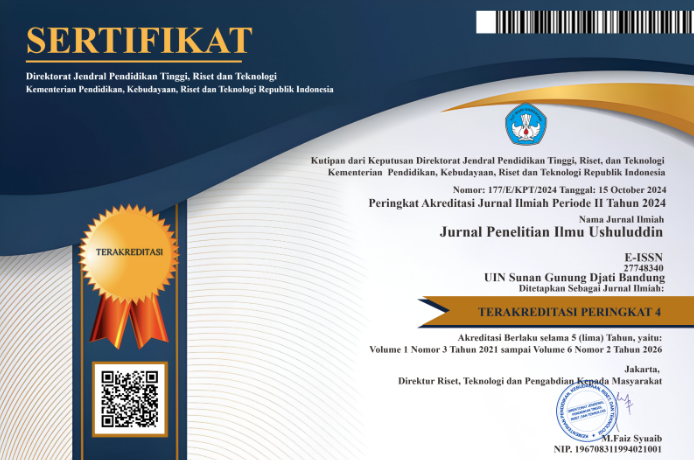The Fana' Concept of Abu Yazid al-Busthomi and Imam Junaid al-Baghdadi (Comparative Study)
DOI:
https://doi.org/10.15575/jpiu.17558Keywords:
Abu Yazid, Baqo', Fana', Imam JunaidAbstract
The concept of fana is a concept that developed in the third and fourth centuries hijriyah. A concept of fusion (trance) which later became an experience desired by many Sufism retainers. A Sufistic experience that must be passed and deliver Sufis at the top of the world of Sufism. with the experience that each Sufi feels so that many bring up various differences between one and another, then it also becomes a phenomenon for the fuqoha'. Abu Yazid al-Busthomi and Imam Junaid al-Baghdadi were one of the pioneers of the concept of Fana’. With a distinctly different background, between Sufi philosophy and Sunni. So the author takes the initiative and aims to combine the views between the two by examining a character who is balanced against and a character who has many adherents to this day, in order to get a good understanding and similarities or differences in the concept of Fana’'. This research uses library research, by means of qualitative analysis. As well as using primary and secondary sources. The results of this study are the concept of Fana’ must be together with the concept of Baqo’, awareness of a person's individuality has disappeared even though his physical form is still there. And to reach the peak of Fana’, the Salikin must leave the nature, character and personality as humans.References
A, B. and M.H, F. (2012) ‘Sufism and Healing’, Culture and Counseling: canadian Perspektive.
Abbas, Q. M. (2004) Abu Yazid Al-Busthomi: al-Majmua’ah as-Shufiyyah al-Kamilah. 1st edn. Damaskus: Al-Mada Publishing Company.
Ahmad, J. (2000) Seratus Muslim Terkemuka. Jakarta: Pustaka Firdaus.
Al-Banjari, M. N. (1785) Ad- Durr an-Nafis. Pulau Minang: Maktabah wa Maktaba’ah Dar al-Ma’arif.
Al-Mazidi, A. F. (2008) Abu Yazid Al-Busthomi: Sulthonul Arifin Fi al-Qorni ats-Tsalist al-Hijri. 1st edn. Lebanon.
Al-Qari, I. I. (1999) The Secret of Sufi: Rahsia Alam Sufi. Kuala Lumpur: Jasmin Enterprise.
An-Nasabury, I. A.-Q. (1997) Risalah Qusyairiyah, Induk Ilmu Tasawuf. Surabaya: Risalah Gusti.
An-Nawawi, I. A. Z. bin S. (2000) Riyadh as-Shalihin. Saudi Arabia: Dar Ibnu al-Jauzi.
Anwar, H. (1995) Sufi al-Junaid. Jakarta: Fikahati Aneska.
Anwar, R. (2010) Akhlak Tasawuf. Bandung: Pustaka Setia.
Ar-Rowi, M. J. A. (2008) Tazkirah Al-Asfiya fi Hayat Al-Awliya. Khanqah Naqshabandiyah.
Arberry, A. . (1991) Sufism: An Account of The Mystics of Islam. Translated by B. Herawan. Jakarta: Mizan.
As-Saraj, A. N. (1974) Kitab al-Luma’ fi at-Tasawuf. Leiden: E.J. Brill.
As-Sulami, A. A. (1998) Ath-Thabaqoth ash-Shufiyyah. Kairo: Muassasat Dar Asy-Sya’b.
As, A. (1994) Pengantar Studi Akhlak. Jakarta: Grafindo Persada.
As, A. (2002) Pengantar Studi Tasawuf. 2nd edn. Jakarta: Raja Grafindo Persada.
Badawi (1949) Syathohat as-Shufiyyah. Kairo: Maktabah an Nahdah al-Misriyyah.
Badrudin (2015) Pengantar Ilmu Tasawuf. 1st edn. Edited by A. A. Dzawafi. Serang: Penerbit A-Empat.
Bidin, M. E. (2009) ‘Konsep Fana dalam Warisan Sufi’. Available at: https://www.researchgate.net.
Gulen, M. F. (2014) Tasawuf untuk Kita Semua: Menapaki Bukit-Bukit Zamrud Kalbu Melalui Istilah-Istilah Dalam Praktik Sufisme. Translated by F. S. Nur. Jakarta: Republika.
Gunandar, J. (2021) ‘Fana’ dalam Pandangan Ulama Sufi: Tinjauan Terhadap Pemikiran Sufi Sheikh Hamzah Fansuri’, Journal of Muslim Societies, 3(2).
Hairudin (2019) ‘Puncak Kulminasi dalam Dunia Tasawuf: Sebuah Kajian Sufistik’, Jurnal Ilmiah Al-Jauhari (JIAJ), 4(1).
Hamka (1984) Tasawuf Perkembangan dan Pemurniannya. Jakarta: Pustaka Panjimas.
Hamka (2016) Tasawuf Perkembangan dan Pemurniannya. Jakarta: Pustaka Panjimas.
Hungopa, R. (2020) ‘Konsep Fana Imam Junaid Al-Baghdadi’.
Jumantoro, T. and Munir, S. (2005) Kamus Ilmu Tasawuf. AMZAH.
Junaid, I. A. al-Q. (1988) Rasail Junaid. Kairo: Dar al-Kutub al-Mishriyyah.
Kader, A. H. A. (2018) Imam Al-Junaid Al-Baghdadi Pemimpin Kaum Sufi. Translated by I. Z. Ibrahim. Yogyakarta: Diva Press.
Kamba, M. N. (2018) Kids Zaman Now Menemukan Kembali islam. 1st edn. Tanggerang: Pustaka IIMaN.
Karamustafa, A. T. (2007) Sufism The Formative Period. Edinburgh: Edinburgh University Press.
Khallikan, A. A. S. A. (1978) Wafiyat al-A’yan wa Abna’ az-Zaman. Beirut: Dar Ash-Shadir.
Khllikan, I. (1299) Wafayat al-A’yan. Kairo.
Mahmud, A. H. (no date) Sulthonul Arifin: Abu Yazid al-Busthomi. 2nd edn.
Mas’ud, A. (2001) Transformasi Sufistik Abu Yazid al-Busthami. Nizamia.
Moleong, L. J. (2002) Metodologi Penelitian Kualitatif. Bandung: Rosda.
Musthofa, M. (1987) Tajul Arifin. Kairo: Darut Thabah al-Mhammaiah.
Naisaburi, F. A. (2015) Tadzkiratul Auliya. 1st edn. Translated by K. Ghoiby. Yogyakarta: Titah Surga.
Nasution, H. (1995) Falsafah dan Mistisisme dalam Islam. Jakarta: Bulan Bintang.
Pakar, S. I. (2013) Tokoh-Tokoh Tasawuf dan Ajarannya. 1st edn. Yogyakarta: Penerbit Deepublish.
Rahmawati (2014) ‘Memahami Ajaran Fana, Baqa, dan Ittihad Dalam Tasawuf’, Al-Munzir, 7(2).
RI, D. A. (no date) Al-Quran dan Terjemahannya. Bandung: PT. Syaamil Cipta Media.
RI, K. A. (no date) Al-Qur’an Hafalan mushaf Al-Yazid. Banten: CV. Al Fatih Berkah Cipta.
Shihab, A. (2001) Islam Sufistik : ‘Isalam Pertama’ dan Pengaruhnya Hingga Kini di Indonesia. Bandung: Mizan.
Siregar, A. R. (1959) Tasawuf dan Sufisme Klasik ke Neo Sufisme. 1st edn. Jakarta: Raja Grafindo Persada.
Sugiyono (2018) Metode Penelitian Kuantitatif, Kualitatif, dan Kombinasi (Mixel Methods). Bandung: Alfabeta.
Sulaeman, M. (2020) ‘Pemikiran Tasawuf Falsafi Awal: Rabi’ah Al-Adawiyah, Al-Bustami, dan Al-Hallaj’, Filsafat dan Pemikiran Islam, 20(1).
Sulanam (2013) ‘From Sufi Order Ritual to Indonesian Islam’, Journal of Indonesian Islam.
Walid, K. Al (2020) TASAWUF FILOSOFIS : Menyelami Samudera Ilmu Tasawuf Filosofis. 1st edn. Jakarta: SADRA INTERNATIONAL INSTITUTE.
Zed, M. (2004) Metode Penelitian Kepustakaan. Jakarta: Yayasan Obor Indonesia.
Downloads
Published
Issue
Section
License
Authors who publish in Jurnal Penelitian Ilmu Ushuluddin agree to the following terms:
- Authors retain copyright and grant the journal right of first publication with the work simultaneously licensed under an Attribution-ShareAlike 4.0 International (CC BY-SA 4.0) License that allows others to share the work with an acknowledgment of the work's authorship and initial publication in this journal.
- Authors are able to enter into separate, additional contractual arrangements for the non-exclusive distribution of the journal's published version of the work (e.g., post it to an institutional repository or publish it in a book), with an acknowledgment of its initial publication in this journal.
- Authors are permitted and encouraged to post their work online (e.g., in institutional repositories or on their website) prior to and during the submission process, as it can lead to productive exchanges, as well as earlier and greater citation of published work (See The Effect of Open Access).












